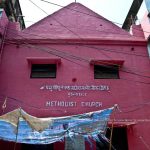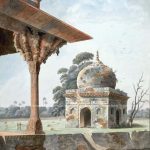Jhandewala Park
Pilgrimage of Lucknow
The Aminabad area in Lucknow is attributed with a peculiar identity system. Every alley, chauraha or park in Aminabad is a distinguished spot on the map of the city. Thus, every “subpart” of Aminabad is actually a part of the whole of Lucknow. One such very important, and one of the most famous, subpart is the Jhande Wala Park.
This ancient spot, known as Bagh Pandain, was so named after Rani Jai Kunwar Pandey, who got a magnificent mosque constructed for her dear friend Khadija Khanam, Begum (wife) of the first Nawab of Oudh, Saadat Khan Burhan-ul-Mulk. This mosque still exists and is called as Pandain Ki Masjid, and has been a symbol of communal harmony in Lucknow. The maqbara of Begum Khadija Khanam was also constructed in front of the masjid, but it has been lost to the vagaries of time, though the grave is still to be seen. During the reign of the fourth Nawab of Awadh Amjad Ali Shah, this area was handed over to his vazir Imdad Hussain Khan Aminuddaulla Sahib and hence it started to be referred to as Imdad Bagh.
During the British rule, in 1914 this area was renovated with roads around the park, which was renamed as Aminuddaulla Park. The Freedom Movement to overthrow the British Rule (activities at Lucknow) has an unforgettable relationship with this park. Brief descriptions of the events are as follows. In January 1928, the tricolour was hoisted for the first time in this park, and it is for this reason that the park is known as the Jhande Wala Park. On 30th November 1928, a meeting was held in this park in support of the agitation opposing the Simon Commission. Pandit Motilal Nehru and Gobind Vallabh Pant were the main speakers in the meeting. On 26th January 1930, ‘Independence Day’ was celebrated in this park. On this occasion the Pledge was taken in support of the slogan ‘Freedom is my Birth Right’.
On 18 April 1930 a massive public meeting was organized during which the ‘Salt Law’ was violated by making salt in the park. In August 1935, after the arrest of Gandhi Ji, in violation of the ban on meetings/ processions imposed by the authorities, Freedom Fighter Gulab Singh Lodhi climbed a tree and hoisted the tricolor for which he was shot dead by the police. On 16th June 1930, Shri Mitai Vishwas and Shri Rameshwar Prasad were arrested for hoisting the tricolor. On 16th July 1930 Sardar Jogender Singh, Sardar Hardutt Singh and Sardar Ram Singh were arrested and imprisoned for six months each for hoisting the Tricolour in the park. On 4th January 1931, Bardauli Diwas was celebrated in the park. On 12 January 1931, Shri Chandra Bhanu Gupt, Shri Parmeshwari Dayal and Shri Kailashpati Verma were arrested, fined and imprisoned.
On 26th January 1931 in spite of obstructions, (by the authorities) the ‘Freedom Day’ was celebrated here. In January 1934, Mahatma Gandhi hoisted the flag and addressed a huge gathering in the park. On 28th December 1935 under the leadership of Respected Bapu, the Golden Jubilee of the Indian National Congress was celebrated and the Tricolour was hoisted. On 26th January 1936, the ‘Freedom Day’ was organized and flag-hoisting ceremony was conducted. In the year 1936, under the leadership of Baba Khijar a procession was taken out and slogans such as ‘Zindabad (Hail) the Year ’57’, ‘Tantya Tope Zindabad’, ‘Maulvi Ahmad Ullah Shah Zindabad’ was raised. In 1938, an exhibition of Khadi was inaugurated by Netaji Subhash Chandra Bose and presided over by Acharya Narendra Deva, in the park. On 26th January 1940 the ‘Freedom Day’ was celebrated and ‘Prabhat Pheries’ (early morning singing of hymns by groups) were organized.
On 14th November 1941, a Jawahar Diwas was held during which Shrimati Shivrajwati Nehru organized a strike at Mahila Vidyalaya and conducted a community flag hoisting at the park, for which the police arrested them. On 12th September 1942, Babu Mohan Lal Saxena was arrested at the park. On 21st September 1942, Freedom fighter Ashalata was arrested here for violating section 129. On 9th August 1943 a huge protest was organized in the park to support the ‘Quit India’ Day. In 1945 Pandit Shiv Narain Dwivedi appeared here after many years of being underground. On 15th August 1947, the happy citizens joyfully celebrated the Independence Day in the Jhande Wala Park. (This memorial was dedicated to the citizens of Lucknow on 26th January 2003.)
The park has had one of the most glorious and meaningful foundations. It has seen events that changed the course of history. It has bore many events that created history in its own lap. But now that all the events are nothing but history as well, there hardly seems a soul bothered about the relevance of that spot. On entering the park, one is welcomed by a plaque, which declares the place as “Azadi Ka Teerth”. But a look around tells a different tale. At one of the corner is statue of martyr Gulab Singh Lodhi with a flag in his hand. Ironically, today, Lodhi’s memorial lies in neglect and so does the statue of Swami Vivekanand. The concrete pedestal has broken at many places. People spit pan masala over the stone plaque on which his preaching’s are engraved. Nearby, one can see a group of people playing cards and smoking `ganja’ under a tree shade. All the lampshades and bulbs installed in the park have been stolen.
A few steps from the statue is the memorial of the `jhanda gaan’ (flag song) “Jhanda ooncha rahe humara…sada shakti barsane wala…iski shaan na jane paaye…” written by Shyam Lal Gupta Parshad, which had become the national anthem of the freedom struggle. But today, the flag pole is missing and the tradition to hoist tricolour on January 26 and August 15 no longer takes place here.
Akansha
Writer is a student, an aspiring painter & calligrapher
(Published in The Lucknow Observer, Volume 2 Issue 14, Dated 05 May 2015)




